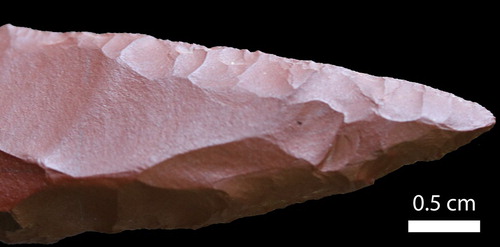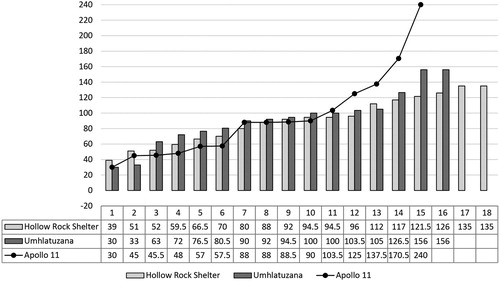ABSTRACT
Dating to roughly 80,000 to 70,000 years ago, components of the Still Bay technocomplex of southern Africa and their potential behavioural implications have been widely discussed. Stone points with invasive retouch, as defined over 90 years ago by Goodwin and van Riet Lowe, serve as markers for Still Bay assemblages, yet many Still Bay sites remain undated and comprehensive, comparable sets of data for their point assemblages remain unpublished. Much of the Middle Stone Age at the site of Apollo 11 in Namibia was undated until 2010, when a potential Still Bay component was announced. Although a Still Bay assemblage at Apollo 11 would represent the most northwesterly and inland expression of this technocomplex, its points have never been fully analysed. This paper presents their morphometric data and an interpretation of point-production strategies. These results are then compared with data obtained for two South African sites: Hollow Rock Shelter in the Western Cape and Umhlatuzana in KwaZulu-Natal. This comparison demonstrates that whereas there are no statistically significant differences in the morphometric data sets between the three sites, there are both similarities and differences in point-production strategies, cross-section shapes and the use of raw materials for knapping. It is suggested that these similarities and variations represent aspects of how knowledge-transfer systems and knapping conventions were followed on both intra-regional and inter-regional scales.
RESUMÉ
Les composantes du technocomplexe du Still Bay d'Afrique méridionale (datant d'il y a 80,000 à 70,000 ans environ) et leurs potentielles implications comportementales ont été largement discutées. Les pointes de pierre avec retouche invasive, un type défini il y a plus de 90 ans par Goodwin et van Riet Lowe, servent d’indicateur des assemblages du Still Bay, mais de nombreux sites du Still Bay restent sans dates et des ensembles complets de données comparables sur leurs assemblages des pointes restent à ce jour inédits. Une grande partie de la séquence de l'âge de la pierre moyen (Middle Stone Age) sur le site d'Apollo 11 en Namibie était sans date jusqu'en 2010, lorsque l’existence d’un assemblage potentiellement attribuable au Still Bay fut annoncée. La présence d’un assemblage du Still Bay à Apollo 11 représenterait l'expression la plus au nord-ouest de ce technocomplexe, et celle se trouvant le plus à l’intérieur des terres. Cependant, les pointes retrouvées sur ce site n'ont jamais été complètement analysées. Cet article présente leurs données morphométriques et une interprétation des stratégies de production de pointes. Ces résultats sont ensuite comparés aux données obtenues pour deux sites sud-africains: Hollow Rock Shelter au Cap Occidental et Umhlatuzana au KwaZulu-Natal. Cette comparaison démontre que, bien qu'il n'y ait pas de différences statistiquement significatives dans les ensembles de données morphométriques entre les trois sites, il existe à la fois des similitudes et des différences dans les stratégies de production des pointes, dans les formes vues en coupe et dans les matières premières utilisées pour la taille. Nous proposons que ces similitudes et ces variations reflètent des aspects de la manière dont les systèmes de transfert de connaissances et les conventions de taille furent suivis aux échelles intrarégionales et interrégionales.
Introduction
The Middle Stone Age of southern Africa dates to between roughly 300,000 and 30,000 years ago and is renowned for genetic, fossil and archaeological evidence that attests to the biological and cultural evolution of early modern humans in the region (e.g. Dusseldorp et al. Citation2013; Lombard et al. Citation2013). The Still Bay technocomplex from several South African sites and its associated behaviours play a key part in this discussion (Henshilwood Citation2012; Wadley Citation2015). Thus far, the Middle Stone Age of Namibia is not that well known and has seldom been integrated into regional studies and debates about past human socio-economies and techno-behaviours. This is probably because most of the relevant archaeological work there was conducted before the advent of luminescence dating methods and because the Namibian material was interpreted according to a scheme different from that used for the South African material (e.g. Vogelsang Citation1998).
Once these obstacles were overcome for Apollo 11 (Vogelsang et al. Citation2010; ) it became apparent that the site’s sequence is similar to that of others in South Africa and Lesotho (see Lombard et al. Citation2012). In fact, Apollo 11 is now recognised as one of the most complete Middle and Later Stone Age sequences in southern Africa that also includes a Still Bay component (Vogelsang et al. Citation2010). This new insight into the Namibian Middle Stone Age sequence opens up the potential for comparative work on a larger, regional scale relating to the spatiotemporal distribution of, and variations in, Still Bay expressions.
Figure 1. Map of southern Africa showing the location of Apollo 11, Hollow Rock Shelter and Umhlatuzana. Current rainfall zones (from Chase and Meadows 2007: 104, ) are marked with light grey and white lines. East and north of the white line is the summer rainfall zone. West of the light grey line is the winter rainfall zone. Between the lines is the year-round rainfall zone. The background map is a composite satellite image of South Africa in November 2002 (https://commons.wikimedia.org/w/index.php?title=File:Composite_satellite_image_of_South_Africa_in_November_2002.jpg&oldid=107710174, consulted 12 June 2017).
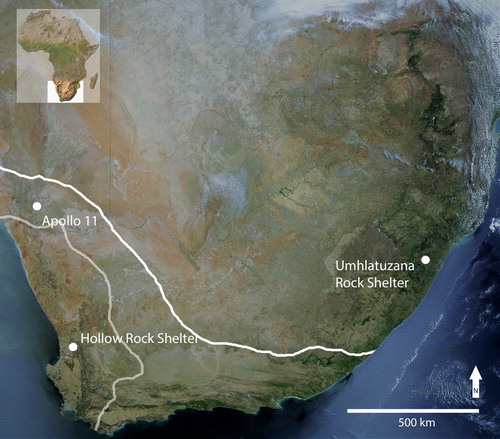
In the context of a regional culture-stratigraphic sequence (Lombard et al. Citation2012), the Still Bay pre-dates the Howiesons Poort. Although the debate regarding its exact time-span continues (Guérin et al. Citation2013; Tribolo et al. Citation2013; Jacobs and Roberts Citation2015, 2017), all but one published age estimate from the site of Diepkloof in South Africa’s Western Cape Province indicate that Still Bay sites were occupied between roughly 80,000 and 70,000 years ago (Jacobs et al. Citation2008a; Tribolo et al. Citation2009, Citation2013; Lombard et al. Citation2010; Vogelsang et al. Citation2010; Högberg and Larsson Citation2011; Feathers Citation2015; Jacobs and Roberts Citation2015). For the purposes of this study, we accept this age range as the current consensus, although preliminary work at Sibudu Cave might indicate a pre-Still Bay presence ∼77,000 years ago at that locality in KwaZulu-Natal in southeastern South Africa (Rots et al. Citation2017).
Notwithstanding the Still Bay’s prominence in the literature, comprehensive typological and/or technological analyses for dated point assemblages currently only exist for Blombos Cave (Villa et al. Citation2009; Mourre et al. Citation2010; Archer et al. Citation2015; Soriano et al. Citation2015), Sibudu Soriano et al. Citation2015), Hollow Rock Shelter (Högberg and Larsson Citation2011; Högberg Citation2014) and Umhlatuzana Rock Shelter (Lombard et al. Citation2010; Mohapi Citation2013). Based on a chaîne opératoire approach, the Still Bay at Diepkloof has been described as ‘a homogeneous phase’ showing similarities with other Still Bay sites (Porraz et al. Citation2013). Detailed, comparative work based on a range of attributes is rare (but see Högberg and Lombard Citation2016a). Previous attempts at regional interpretations based on selected morphometric (e.g. Archer et al. Citation2016) or limited technological traits (e.g. Mackay et al. Citation2014) produced conflicting results about the possible demographic dynamics during the Still Bay (see discussion in Högberg and Lombard Citation2016a).
The Still Bay type fossil is a thin (≤10 mm), invasively retouched, bifacial, foliate or lanceolate point with a semi-circular or wide-angled pointed butt and a lenticular cross-section (Goodwin and van Riet Lowe Citation1929). Understood as a technocomplex (see discussion in Lombard et al. Citation2012), we expect to see assemblages sharing a context or class of artefacts with many, but not all, properties in common. Each Still Bay assemblage could thus include different styles of the same family of artefacts (such as points), as a response to common socio-economic and/or environmental factors (Clarke Citation1968). A technocomplex, such as the Still Bay, can thus be widespread (Sampson Citation1974), with subtle shifts in tool frequencies, design or style, whilst retaining broad similarities (Deacon Citation1980).
Based on observable and measurable characteristics (such as elongation, thinness or cross-section shapes), style has been defined as something that is spatiotemporally unique (Sackett Citation1982). Variation in style could reflect the social identity of a group/society, either consciously (e.g. Wiessner 1983, 1985) or passively (e.g. Sackett Citation1982). Working with material from the Middle Stone Age, Thackeray and Kelly (Citation1988: 23) suggested, however, that the stylistic attributes recognised by archaeologists are ‘a reflection not of social reality, but rather the structuring principles of the society — the way things might be ideally — rather than the way they are in practice’.
Because ‘much of human niche construction is guided by socially learned knowledge and cultural inheritance’ (Odling-Smee et al. Citation2003: 260), we suggest that one way of looking at these structuring principles is by exploring knowledge-transfer systems. The actions of toolmakers are intimately constrained by the knowledge-transfer systems in which they are situated (Riede Citation2006). Technologies and their attributes are thus embedded in social knowledge systems (Lemonnier Citation1993) and knowledge transmission from one generation or group to another is performed in that context. The reconstruction of production strategies for stone tools (such as Still Bay points) reveals traditions of knowledge-transfer systems as processes of production techniques and their conceptual roots (Karlin and Julien Citation1994). With adequate spatiotemporal resolution, such work could contribute to the hypothetical reconstruction of relationships between generations and/or communities based on the attributes of their artefacts.
Even though the Still Bay point inventory from Apollo 11 Rock Shelter has played a prominent role in discussions surrounding the definition and spatiotemporal spread of the Still Bay, and has been mentioned in demographic reconstructions (e.g. Conard et al. Citation2014; Mackay et al. Citation2014; Archer et al. Citation2016), a detailed analysis of the points themselves has not yet been presented. Building on previous work (Villa et al. Citation2009; Högberg and Larsson Citation2011; Högberg and Lombard Citation2016a), we developed an approach for the direct, detailed comparison of invasively retouched bifacial and unifacial point assemblages. This approach constitutes a matrix analysis in which several attribute-based knapping strategies — as observed on all the preforms, whole and broken points of each assemblage — are interpreted in terms of a five-phase production sequence and the use of raw materials for knapping. We propose that these knapping strategies represent knowledge-transfer systems (shared traditions) between generations of point knappers and/or between groups on the landscape. Here, we present the morphometric data and knapping strategies recorded for Still Bay points from Apollo 11 and compare the results with those from other sites for which suitable data are available.
Apollo 11 and its Still Bay assemblage
Wendt (Citation1976) initially excavated Apollo 11 almost 50 years ago and his excavation was subsequently re-opened by Vogelsang et al. (Citation2010) to collect new samples for dating its sequence and for establishing a finer degree of chronological differentiation for the site’s lithic assemblages. Vogelsang (1998; Vogelsang et al. Citation2010) provides thorough discussions of the site’s physical setting, environment and excavation history and we therefore give only a short summary here. Oriented northwest, Apollo 11 is about 28 m wide and 11 m deep and is situated in the semi-desert of the western foothills of Namibia’s Huns Mountains, an area dominated by Dwarf Shrub Savanna. The site is about 20 m above the valley floor on the eastern slope of the ephemeral Nuob River, which feeds into the Gariep/Orange River drainage system (). Apollo 11’s geology is associated with the black limestone of the southern Witputs sub-basin of the Nama Group with inclusions of shale, sandstone and quartzite, unconformably underlain by the Namaqualand Metamorphic Complex (Vogelsang et al. Citation2010). Currently, the region is located in the modern/Holocene year-round rainfall zone (Chase and Meadows Citation2007), with a mean annual precipitation of less than 100 mm and high variation in rainfall from year to year (Vogelsang et al. Citation2010).
Figure 2. Apollo 11 Rock Shelter (in the middle, bottom third of the image) in the foothills of the Huns Mountains, Namibia. Photograph kindly provided by Ralf Vogelsang.
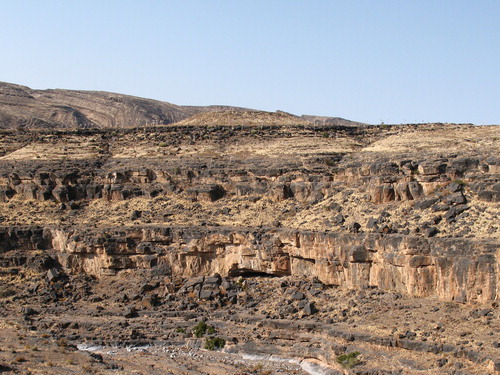
Vogelsang et al. (Citation2010) cautiously identified the Still Bay at Apollo 11 as the unit previously known as MSA 2 and dated with OSL to 71,000 ± 3000 years ago (Vogelsang Citation1998). As is the case for other long-sequence Middle Stone Age sites in southern Africa (Lombard et al. Citation2012), the Still Bay at Apollo 11 is overlain by the Howiesons Poort technocomplex with an OSL age estimate of 63,000 ± 2000 years, from which it is separated by a thin sterile layer dating to 67,000 ± 3000 years ago (Vogelsang et al. Citation2010). Although the points seem less elongated than those typically attributed to the Still Bay technocomplex from sites such as Blombos, Sibudu and Diepkloof (e.g. Villa et al. Citation2009), Vogelsang et al. (Citation2010) report that the typical ‘Still Bay facial retouch’ is represented on four bifacial points, 14 unifacial points and 13 edge-retouched points. They describe seven ‘basal end scrapers on pointed blades’ as a separate category. According to their analysis, retouched tools constitute 6.8% of the complete Still Bay assemblage, which contains 5521 artefacts. Quartzite is the preferred material used for 52.4% of the assemblage. This material is mostly of a fine-grained quality, obtained from the local riverbed and nearby outcrops. Calcareous mudstone was used for 34.0% of the assemblage (Vogelsang et al. Citation2010). Interesting organic finds from the Still Bay context at Apollo 11 include ostrich eggshell fragments with fractures that point to the use of ostrich eggshell flasks, along with two rib fragments with notches (Vogelsang Citation1998; Vogelsang et al. Citation2010).
Our approach
Before starting our analysis, we worked through the whole lithic assemblage from the Wendt and Vogelsang excavations stored at the National Museum of Namibia to ensure that we had seen all the potential points, point preforms, point fragments and bifacial thinning flakes. We analysed all point-related pieces of the MSA 2 or Still Bay from Apollo 11 as identified by Vogelsang et al. (Citation2010), by building on the method described in Högberg and Lombard (Citation2016a). First, we conducted an attribute analysis including typological, morphometric and technological aspects of each uniquely numbered piece, including all the finished points, unfinished points, point preforms and broken points from the assemblage (N = 25; ). We included in our analysis pieces not previously detected as point fragments, but identified as such while working systematically through the whole lithic assemblage.
Figure 3. The points, preforms and point fragments from Apollo 11 Rock Shelter included in the present analysis. The pieces are arranged according to completeness or fragmentation as represented in Table 4.
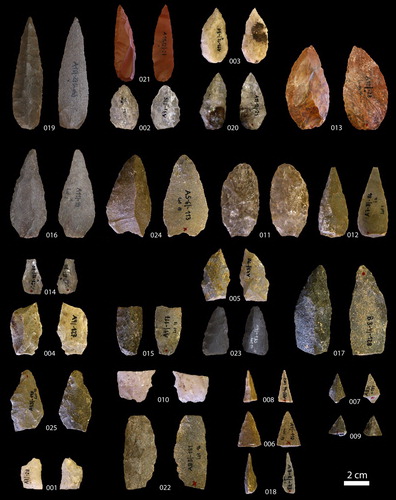
To facilitate future replication, we present our analytical and interpretative matrix method in a series of tables and figures below (see also Högberg and Lombard Citation2016a). In sum, the recorded attributes include raw material, the fragment type/completeness of the piece (), length-width-thickness measurements, the base shape, the cross-section (), the centredness of the dorsal ridge at the bilateral equilibrium, the placement of the bifacial equilibrium plane, whether the pieces were worked on one or both sides, the blank type () and the use of pressure flaking as defined by Crabtree (Citation1973), Patten (Citation1978) and Patterson (Citation1998) (see also Mourre et al. Citation2010; Högberg and Lombard Citation2016b). Based on a matrix of these criteria we interpret, where possible, the production phase () and point-production strategy for each piece (see and for hypothetical interpretative matrices).
Figure 4. Description of complete points, fragment types and cross-sections as used in the analysis.
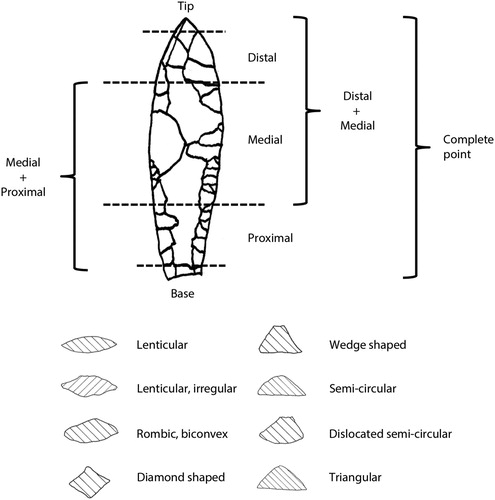
Figure 5. Illustration of the interpretative matrix with identified point-production phases and strategies (slightly modified from Högberg and Lombard 2016a: 10, ).

Table 1. Analytical method/procedure: definition of attributes used during the analysis of points from the Apollo 11 Rock Shelter Still Bay context.
Table 2. Definitions for interpreting production phases (modified from Högberg and Lombard Citation2016a: 6, ).
Table 3. Matrix for attributes and definitions in relation to point-production strategies and production phases used in the analysis, described for phase 2, 3 and 4 points (from Högberg and Lombard Citation2016a: 9-10, ).
Results
The Still Bay points from Apollo 11 Rock Shelter
Most of the retouched points, point preforms and broken points from the Apollo 11 Still Bay context (N = 25) (, ) are made of quartzite (N = 15, 60%). Quartz is the second most common raw material used (N = 7, 28%), with four examples in crystal quartz, two in milky quartz and one in rose quartz. Three points are made of other rock types, namely cryptocrystalline rocks (N = 2) and calcareous mudstone/hornfels (N = 1).
Table 4. Analytical data from all 25 points from Apollo 11 Rock Shelter (see , and for the definition of attributes).
The points from Apollo 11 associated with the Still Bay context are in different phases of production. Most (N = 20, 80%) are in phase 2 (early worked pieces) or phase 3 (preforms). We identified a single phase 5 finished point (unique number 019; ). Apart from the plentiful Blombos Cave assemblage (Villa et al. Citation2009), whole phase 5 points are under-represented at most sites because most pieces are broken or unfinished. In our analyses we therefore use the data for all the whole and almost whole points throughout production phases 2-5. Consequently, our results and interpretations for both Apollo 11 and the comparative work discussed below are skewed towards the higher end expected for Still Bay point assemblages with larger numbers of phase 4 and 5 points. Data for the separate production phases at Apollo 11 can be extracted from .
Slightly more than two-fifths of the points are whole or almost whole (N = 11, 44%). The rest of the assemblage represents a range of fragment types (). When the whole (complete) and almost whole pieces are separated out from the rest of the population, morphometric trends point towards an aim of producing elongated, narrower points with a thickness of ≤10 mm. Nine (82%) of the whole and almost whole pieces are ≤10 mm thick, regardless of their production phase (). Relatively small standard deviations of 0.6 and 0.4 in the length:width and width:thickness ratios respectively indicate a strong relationship in these aspects during point production and the anticipated end product (), whereas a length:thickness relationship is less pronounced, probably because general thinness is maximised for each piece. Only the width:thickness ratio shows some standardisation with a coefficient of variation value (CV) below 20 (; Fisher Citation2006).
Figure 6. The relationships between length, width and thickness measurements for the complete and almost complete Apollo 11 pieces (see and Table 4), arranged from thinnest to thickest, with standard deviation bars and trend lines for each dimension.
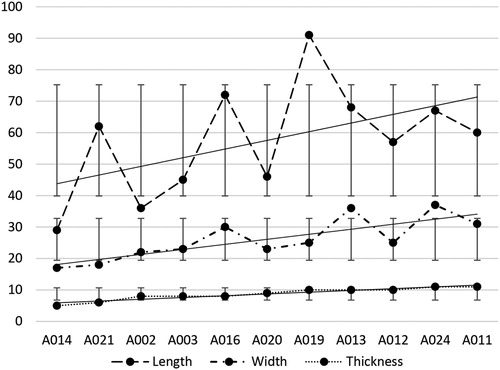
Table 5. Summary of the morphological data of whole and almost whole pieces (N = 11) from Apollo 11 Rock Shelter.
Three of the whole points have the characteristic semi-circular butt usually associated with finished Still Bay points and none seem to have been shaped deliberately to display wide-angled pointed butts. All three points with semi-circular butts are unifacial points with invasive retouch. Invasive bifacial retouch has been recorded on eight (32%) of the point fragments, so that we were unable to assess base shapes for bifacially worked points in the assemblage. More than half of the pieces in the assemblage miss their proximal ends or bases/butts (N = 14, 56%). Of the bifacial pieces, all but one (87.5% of bifacial pieces and 28% of the whole assemblage) have lenticular or irregular lenticular cross-sections. Of the unifacial pieces (N = 17), eleven (65% of unifacial pieces and 44% of the whole assemblage) have triangular cross-sections, making this the most common form of cross-section.
Other forms of cross-sections as defined in and shown in are present on a few examples (). We have not recorded any pieces with rhombic, biconvex or diamond-shaped cross-sections. Diamond-shaped cross-sections are associated with points produced from blade blanks (Högberg and Lombard Citation2016a: 10, ). Based on these observations, we conclude that blades were probably not used as blanks for the points from Apollo 11. This inference is further supported by the fact that where identification of blanks was possible, nodules (N = 7, 41%) and flakes (N = 10, 59%) were identified as blanks (instead of blades) for the production of the Still Bay points present. We note, however, that for almost one third of the points (N = 8, 32%) we were unable to determine the blank type.
The most commonly used strategy to manufacture the points recovered from Apollo 11 is the unifacial point-production strategy (N = 17, 71%). Seven (29%) of the pieces were made using the bifacial nodule point-production strategy 1. For one point, we were not able to determine a point-production strategy. The majority of the points and point fragments (N = 15, 60%) have a ridge at the bilateral equilibrium, following the original ridge of a flake on one side and lacking a ridge on the other. These pieces are associated with the unifacial point-production strategy. Also associated with this strategy, are the points and point fragments (N = 17, 68%) worked on one side only (). Nine (36%) of the pieces do not have a clearly defined ridge at the bilateral equilibrium on each face on the point, while 22 (88%) do not have a centred bifacial equilibrium plane (). Pressure flaking was used for the production and final shaping of six (two in phase 3, three in phase 4 and one in phase 5) of the points and point fragments at Apollo 11 ( and ).
Table 6. Summary of some technological attributes.
Inter-regional variation in Still Bay point morphologies and production strategies
Here, we compare directly the Apollo 11 morphometric results with those from Hollow Rock Shelter and Umhlatuzana Rock Shelter (Högberg and Lombard Citation2016a) to affirm the Still Bay status of the Apollo 11 assemblage. We then explore inter- and intra-regional trends in knowledge-transfer systems based on point-production strategies. While some other dated Still Bay assemblages have been described, published morphometric data sets for their point populations are few (see Archer et al. Citation2015, Citation2016; Soriano et al. Citation2015 for discussion) and the Apollo 11 sample of 25 pieces is relative small. Pending further excavation at the site, our study nevertheless comprises all the material representing the Apollo 11 Still Bay point population and as such contributes to inter-regional discussions of this technocomplex. As is true for most assemblages, greater numbers of artefacts generated by future excavations might affect our interpretations of the data.
Comparative morphometric analysis
Morphometrically, the mean metric values reveal that the shape of the Apollo 11 points is almost identical to that of the Umhlatuzana assemblage and very similar to that of Hollow Rock Shelter (). At all three sites, the shape ratio (length:width, length:thickness and width:thickness) mean values are very similar. The points from Hollow Rock Shelter are, on average, slightly wider, thicker and somewhat longer, compared to those from Apollo 11 and Umhlatuzana (). A one-way analysis of variance test (ANOVA) for independent samples revealed that there are no statistically significant differences between the shape ratios of the three samples (length:width p = 0.115; length:thickness p = 0.204; width:thickness p = 0.062).
Figure 8. Comparative mean morphometric values for Still Bay complete and almost complete point assemblages from Apollo 11 Rock Shelter (N= 11), Hollow Rock Shelter (N = 20; 13 whole points, six whole points with tip or base missing and one point with lateral break [Högberg and Larsson 2011: 137, Table 3]) and Umhlatuzana Rock Shelter (N = 16, including eight serrated points [Lombard et al. 2010]). The data include points from all phases of manufacture.
![Figure 8. Comparative mean morphometric values for Still Bay complete and almost complete point assemblages from Apollo 11 Rock Shelter (N= 11), Hollow Rock Shelter (N = 20; 13 whole points, six whole points with tip or base missing and one point with lateral break [Högberg and Larsson 2011: 137, Table 3]) and Umhlatuzana Rock Shelter (N = 16, including eight serrated points [Lombard et al. 2010]). The data include points from all phases of manufacture.](/cms/asset/7e74453a-afec-4643-87a1-a2d0b06a14ec/raza_a_1513240_f0008_ob.jpg)
The comparison of morphometric values demonstrates that points from the three sites are similar in shape. The standard deviations for all the shape ratios show that even from the early stages of manufacture point shape deviated little (or not at all) at the three sites (). We interpret this result to be a strong indication that ‘shape’ was an important aspect of Still Bay point production. Similar to what has been previously established for the Still Bay points from Umhlatuzana (Lombard et al. Citation2010), the emphasis of the points’ makers appears to have been especially placed on the length:width ratio of points also at Apollo 11 and Hollow Rock Shelter, with means and standard deviations being almost identical at all three sites. Across the board, the Umhlatuzana assemblage shows the least deviation in size and shape, whereas the points from Hollow Rock Shelter display the most deviation regarding width and thickness. At Apollo 11, length was the least consistent morphometric dimension, but was still very similar to that at Hollow Rock Shelter.
Figure 9. Comparative standard deviation values for Still Bay complete and almost complete point assemblages for Apollo 11 Rock Shelter, Hollow Rock Shelter and Umhlatuzana Rock Shelter. The samples are the same as described for .
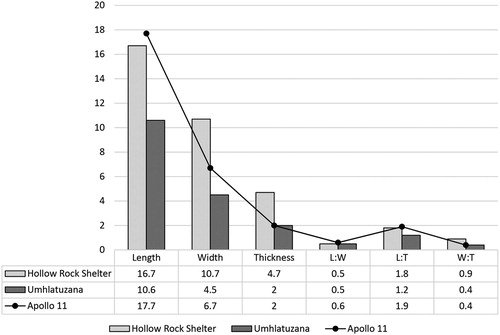
Generally, the smaller the standard deviations (SD), the smaller are the values for the coefficient of variation and thus the greater the degree of standardisation. Fisher (Citation2006) used 20 as a cut-off point to indicate standardisation in lithic assemblages and, being cautious, Wadley and Mohapi (Citation2008) suggested a value of 10 as a clear indication of standardisation. Using Fisher’s benchmark, we see that only the points from Umhlatuzana show some standardisation in terms of length, width and their width:thickness ratio, the dimension for which the Apollo 11 point assemblage also displays some standardisation, but this is the least standardised metric at Hollow Rock Shelter (). If we follow the parsimonious approach of Wadley and Mohapi, however, it seems that notwithstanding an emphasis on shape, the trend for Still Bay point populations in general is not to be particularly standardised regarding either size or shape (). We nevertheless again draw attention to the fact that pieces of all the production phases are included so that values are skewed towards the higher end of the expected range for Still Bay points.
Figure 10. Comparative coefficient of variation (CV) values for Still Bay complete and almost complete point assemblages for Apollo 11 Rock Shelter, Hollow Rock Shelter and Umhlatuzana Rock Shelter. The samples are the same as described for .

Our current data set indicates more similarity between the point populations from Apollo 11 and Umhlatuzana, with that from Hollow Rock Shelter being somewhat different and width the least standardised of all dimensions (). Because early-phase points are included here, the original nodule sizes, affected by rock type amongst other things (see section on raw material use below), would also result in inflated SD and CV values. For example, when large quartzite nodules are mostly chosen for production blanks (as with some of the pieces from Hollow Rock Shelter), we may expect a substantial difference in proportions, and sometimes also shape ratios, between phase 1 and phase 5 points at the site (a large nodule is heavily knapped into a point, continuously changing size and shape). On the other hand, when small nodules or blades are chosen (such as those at Umhlatuzana), there will be slighter differences in proportions and shape ratios between phase 1 and phase 5 points (much less reduction is required to knap such pieces into shape).
We also conducted a comparative analysis of the relationship between the recorded cross-sections for Still Bay points at Apollo 11, Hollow Rock Shelter and Umhlatuzana (). Although we followed a fine-grained procedure during recording in the context of identifying point-production strategies, here we conflate similar cross-section categories (lenticular/lenticular-irregular and semi-circular/dislocated semi-circular) to correlate with the archetypal Still Bay point definition provided by Goodwin and van Riet Lowe (Citation1929). In the Apollo 11 assemblage most pieces have triangular cross-sections (N = 11, 45.8%). Here, we recorded lenticular cross-sections on six pieces (25%), semi-circular cross-sections on four (16.7%) and wedge-shaped on three (12.5%) (). The Hollow Rock Shelter assemblage, on the other hand, contains no pieces with triangular cross-sections and only two cross-section shapes are represented, in almost equal proportions, i.e. semi-circular (N = 33, 51%) and lenticular (N = 31, 48.4%) (). The narrow assortment of cross-section shapes at Hollow Rock Shelter is interesting because at least four different point-production strategies have been identified for Still Bay points at this site. The Umhlatuzana assemblage is dominated by pieces with lenticular cross-sections (N = 41, 47.7%). Here, wedge-shaped (N = 16, 18.6%) and semi-circular (N = 14, 16.3%) cross-sections are almost equally frequent, while pieces with triangular (N = 6, 7.2%) and diamond-shaped cross-sections (N = 4, 4.7%) are relatively rare.
Figure 11. Frequencies in the percentage of cross-section shapes recorded for each assemblage analysed. Note that similar cross-sections, such as lenticular and lenticular-irregular or semi-circular and dislocated semi-circular, have been conflated. Cross-sections of fragments are not always clearly identifiable, thus only pieces with secure cross-section identifications are included here.
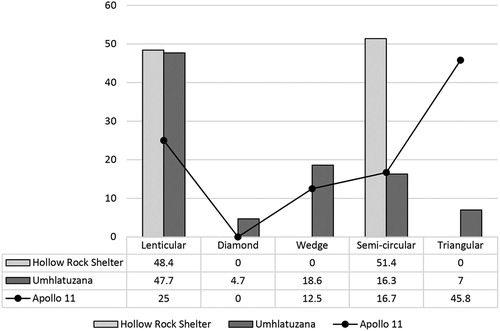
A decade or so ago, values for tip cross-sectional areas (TCSA, calculated by multiplying half the maximum width by the maximum thickness) were thought to inform on weapon-delivery systems (Shea Citation2006; but see Sisk and Shea Citation2009; Lombard and Phillipson Citation2010). Because weapon use was a hot topic of research and TCSA values can be calculated from broken points (as long as their maximum widths and thicknesses are intact), data are available for this metric attribute for many dated Still Bay sites (Shea Citation2006; Wadley Citation2007; Villa et al. Citation2009; Mohapi Citation2013). We therefore use TCSA values not to infer function, but as a directly comparable morphometric attribute that might reveal general trends in Middle Stone Age point production through time.
We compare the TCSA values calculated for the points and point fragments representing production phases 3-5 (thus excluding blanks and initially worked pieces) at Apollo 11, Hollow Rock Shelter and Umhlatuzana. Most points (N = 41, 90%: Apollo 11 N = 12, 80%; Hollow Rock Shelter N = 17; 94%; Umhlatuzana N = 12, 75%) have TCSA values of between 40 and 140 (). The points from Hollow Rock Shelter are most consistent in this attribute, with those from Apollo 11 displaying the most deviation, but only two pieces have values above 140. Conducting an ANOVA test for independent samples resulted in a value of p = 0.0970, showing no statistically significant differences between the three samples.
Comparative point-production strategy analysis and raw materials
Still Bay points from the Apollo 11 assemblage were produced using the bifacial nodule point-production strategy version 1 and the unifacial point-production strategy (see and ). For one point, we were unable to specify a point-production strategy (). Whereas the bifacial nodule point-production strategy version 1 starts from a raw, naturally formed or slightly worked nodule or nodule-like flake, the unifacial point-production strategy starts with a flake blank (). Hypothetically, a blade can also be used as a blank for the unifacial point-production strategy. We have, however, no evidence of blades having been used as blanks from Apollo 11. With the bifacial nodule point-production strategy version 1, the point is worked on both planes using all sides on the lateral margins as platforms for knapping throughout the production process. With the unifacial point-production strategy, only the ventral side of the flake is used as a platform. Invasive flakes are detached to shape the dorsal side of the flake into a point. The ventral side of the original flake blank is left unworked. Consequently, two very different strategies were used to produce the Still Bay points excavated from Apollo 11.
In a previous study, we analysed regional variations in point-production strategies, comparing the Still Bay assemblages from Hollow Rock Shelter with those from Umhlatuzana (Högberg and Lombard Citation2016a). Here, we compare and discuss these results with new data on point-production strategies from Apollo 11. There are striking similarities and differences between the three sites (). At all of them there is evidence of points having been produced with the bifacial nodule point-production strategy version 1 and the unifacial point-production strategy. However, the relative frequency of these strategies varies. At Apollo 11 the unifacial point-production strategy is most common, with 68% (N = 17) of points produced using this strategy. At Hollow Rock Shelter, however, only 4.35% (N = 3) and at Umhlatuzana 16.5% (N = 16) of points were produced using the unifacial point-production strategy. On the other hand, at Hollow Rock Shelter (55.1% N = 38) and Umhlatuzana (42% N = 41) most points were produced with the bifacial nodule point-production strategy version 1, whilst at Apollo 11 only 28% (N = 7) of points were produced in this manner.
Table 7. All points included in the present analysis from Apollo 11 Rock Shelter, Hollow Rock Shelter and Umhlatuzana Rock Shelter presented in numbers and percentage of the whole assemblage of points for each point-production strategy (top percentage line), as well as in relation to stone type used (bottom percentage line). Note that crystal quartz points from Umhlatuzana Rock Shelter and Apollo 11 Rock Shelter, as well as a point made out of rose quartz from Apollo 11, are all included in the quartz data below. Data on Hollow Rock Shelter and Umhlatuzana Rock Shelter are from Högberg and Lombard (2016a: 16, ).
Apollo 11 is the only site out of the three where points were produced using only two production strategies. At both Hollow Rock Shelter and Umhlatuzana knappers used four different strategies. However, the bifacial nodule point-production strategy version 2 was used only for points from Hollow Rock Shelter and the bifacial blade point-production strategy is thus far unique to some of the points from Umhlatuzana. Both of these sites have points produced with the bifacial flake point-production strategy, a strategy that we have not recorded at Apollo 11.
Pressure flaking is known to have been a technique used for the production of Still Bay points (Mourre et al. Citation2010; Högberg and Lombard Citation2016b). At Hollow Rock Shelter it was used for the final shaping of points (Högberg and Larsson Citation2011), while at Umhlatuzana pressure flaking was used for the final shaping of Still Bay points, the deliberate flaking of serrated edges and the thinning of point preforms (Högberg and Lombard Citation2016b). The use of pressure flaking at Apollo 11 is similar to that of Hollow Rock Shelter, i.e. it was used for the final shaping of some points.
At all three sites, knappers used quartzite and quartz to knap Still Bay points, but the frequencies in which they did so differ (). At Apollo 11, quartzite was used more frequently, while at Hollow Rock Shelter quartz was used less frequently. Other, local rock types were used at all three sites, such as silcrete at Hollow Rock Shelter, hornfels at Umhlatuzana and cryptocrystalline/calcareous mudstone at Apollo 11. (Note that here we use the term ‘local’ for rock types that are represented in the point assemblage at only one of the three sites. We do not imply that these rock types were always locally extracted).
Figure 13. Frequencies of each point-production strategy in relation to rock type for each site. The diagram is based on the numbers given in Table 7. White: bifacial nodule strategy 1; grey background with white dots: bifacial nodule strategy 2; light grey: bifacial blade strategy; dark grey: bifacial flake strategy; checkered grey and white: unifacial strategy; white background with black dots: not known.
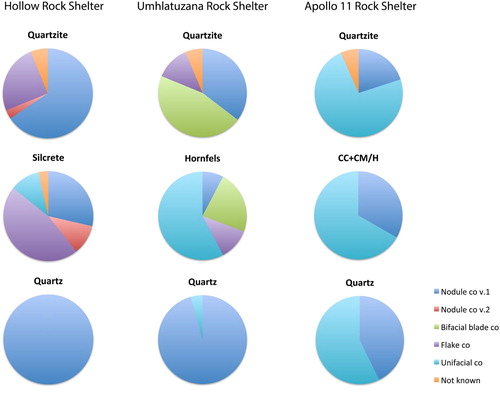
Looking at preferred point-production strategies for the various rocks, we also observed interesting variation between the sites. At Apollo 11, knappers made most points on all three rock categories using the unifacial strategy; this strategy dominates amongst quartzite points in particular (N = 11), with more points attempted using the bifacial nodule point-production strategy version 1 on quartz (N = 3) and local materials (N = 1). On the other hand, at Hollow Rock Shelter knappers seem to have preferred this latter strategy to produce points on quartzite (N = 21) and quartz (N = 9), but mostly used the bifacial flake strategy for silcrete (N = 13). At Umhlatuzana, we observed a preference for three different point-production strategies on the three raw material groupings. Here, knappers mostly used the bifacial blade point-production strategy for quartzite (N = 22), the unifacial strategy for hornfels (N = 15) and the bifacial nodule point-production strategy version 1 for quartz points (N = 22).
Returning to the course-grained (morphological as opposed to technological) data on cross-sections () and exploring their relationships with the use of raw materials, we found that at all three sites knappers made, or attempted to make, points with lenticular cross-sections from all the raw materials in their assemblages (). At Apollo 11 (N = 24) equal numbers of lenticular pieces (N = 2, 8.3%) were produced on quartzite, quartz and local fine-grained rocks. At Hollow Rock Shelter (N = 64) most lenticular pieces were made from quartzite (N = 15, 23.4%) or silcrete (N = 11, 17.2%), with only five (7.8%) of the pieces on quartz. At Umhlatuzana (N = 86), on the other hand, quartz was the preferred material for the production of pieces with lenticular cross-sections (N = 22, 25.6%) followed by quartzite (N = 17, 19.8%). Here, only two (2.3%) hornfels pieces have lenticular cross-sections ().
Apollo 11 has no pieces with diamond-shaped cross-sections and this type of cross-section, as well as wedge-shaped and triangular cross-sections, is absent from the Hollow Rock Shelter assemblage. The Umhlatuzana assemblage has four pieces with a diamond-shaped cross-section (4.2%), all of which were produced on quartzite. At both Apollo 11 and Umhlatuzana knappers used mostly quartzite (Apollo 11 N = 2, 8.3%; Umhlatuzana N = 16, 18.6%), but sometimes also local fine-grained rocks (Apollo 11 N = 1, 4.2%; Umhlatuzana N = 5, 5.8%) to produce pieces with wedge-shaped cross-sections. Quartzite was mostly used to produce pieces with triangular cross-sections at both Apollo 11 (N = 8, 33.3%) and Umhlatuzana (N = 5, 5.8%). At Apollo 11, the knappers also produced a few such pieces on quartz (N = 2, 8.3%) and one (4.2%) on a local fine-grained material, as at Umhlatuzana (hornfels N = 1, 1.2%), where no quartz pieces with triangular cross-sections were recorded ().
Figure 14. Frequencies of cross-sections represented in each assemblage in relation to raw material. Note that similar cross-sections, such as lenticular and lenticular-irregular or semi-circular and dislocated semi-circular, have been conflated. Cross-sections of fragments are not always clearly identifiable, thus only pieces with secure cross-section identifications are included here. Abbreviations used: A Apollo 11 Rock Shelter; H Hollow Rock Shelter; U Umhlatuzana Rock Shelter; lent lenticular; diam diamond-shaped; sem-cir semi-circular; trian triangular.
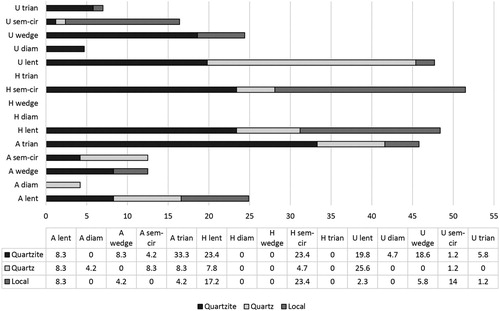
Pieces with semi-circular cross-sections were produced at all three sites. At Apollo 11, quartz was used for two (8.3%) and quartzite for one (4.2%) of these. All rock types were used for such pieces at both Hollow Rock Shelter and Umhlatuzana. At Hollow Rock Shelter, equal proportions of pieces with semi-circular cross-sections were made from quartzite and silcrete (N = 15, 23.4% each), with three (4.7%) from quartz. At Umhlatuzana, hornfels dominates this category with 12 pieces (14%) and this site yielded only one piece (1.2%) made of quartzite and one (1.2%) of quartz ().
Discussion and conclusion
Notwithstanding a still small sample size, our comparative data enable us to start integrating the Apollo 11 Still Bay point assemblage with available inter-regional results and interpretations about the Still Bay technocomplex. Vogelsang et al. (Citation2010) were cautious with their interpretation of the MSA 2 assemblage at Apollo 11 as Still Bay. Our analyses substantiate their reading. Whereas Still Bay assemblages may vary in some aspects across space and through time (Archer et al. Citation2015, Citation2016), the MSA 2 point assemblage from Apollo 11 falls within the known morphometric range of Still Bay points ( and ), with no statistically significant differences in the three shape ratios compared to Hollow Rock Shelter and Umhlatuzana.
Goodwin and van Riet Lowe (Citation1929) defined the Still Bay type fossil as having a lenticular cross-section. We found that at all three sites in our analysis, points had lenticular and semi-circular cross-sections. Compared to Hollow Rock Shelter and Umhlatuzana, Apollo 11 had relatively fewer lenticular pieces (). Pieces with lenticular cross-sections are the only category present at all three sites made on all three raw material types (quartzite, quartz and local rocks; ). We suggest that this shows the general, inter-regional intent of the knappers to produce thin, bifacial points regardless of raw-material constraints. Technologically, we associate lenticular cross-sections with the bifacial nodule point-production strategy 1 (phases 2-4) and bifacial nodule point-production strategy 2 (phase 2). The bifacial nodule point-production strategy 1 was used extensively to produce Still Bay points at Hollow Rock Shelter and Umhlatuzana and is the only one thus far reported for the Blombos assemblage (Villa et al. Citation2009).
The use of the bifacial nodule point-production strategy 1 approach at all the Still Bay sites we have thus far analysed, as well as at Blombos and Diepkloof (Villa et al. Citation2009; Porraz et. al 2013), indicates a potentially inter-regional shared convention for Still Bay point production (Högberg and Lombard Citation2016a). This interpretation implies that, despite the complexities inherent in the sharing of knowledge-transfer systems within and between groups (Högberg and Lombard Citation2016a), during the Still Bay society was potentially organised in a way that facilitated knowledge transmission about conventions of how to make a point and that these shared conventions were applied across regions, including Apollo 11.
The most parsimonious interpretation for such widespread knowledge transmission across bioregions and/or rainfall zones would be that it was accomplished through exchange networks amongst neighbouring hunter-gatherer groups of adjacent bioregions, as opposed to the long-distance movement of individuals or groups across the landscape. When knowledge-transfer systems are thought of in this manner, it becomes evident that key knapping principles for the production of Still Bay points could have been transferred across long distances through chains of short-distance interactions (for a fuller discussion see Högberg and Lombard Citation2016a).
In our technological analysis, we distinguish between semi-circular and dislocated semi-circular cross-sections (). Dislocated semi-circular cross-sections are associated with phases 3 and 4 of the bifacial flake point-production strategy as observed at Hollow Rock Shelter and Umhlatuzana, but are absent at Apollo 11. However, they are also relevant for the identification of phase 3 pieces made according to the unifacial point-production strategy, which was used by knappers at all three sites. Semi-circular cross-sections also define phase 4 points produced with the unifacial point-production strategy (, and ). Whereas complete, finished bifacial points with lenticular cross-sections might be the type fossil for the Still Bay, all previously fully described Still Bay point assemblages also include unifacial points (Minichillo Citation2005; Wadley Citation2007; Villa et al. Citation2009; Högberg and Larsson Citation2011; Porraz et al. Citation2013; Högberg and Lombard Citation2016a), although these are often neglected during formal analyses (e.g. Villa et al. Citation2009; Archer et al. Citation2016).
Most pieces in the Apollo 11 assemblage and some of the Umhlatuzana pieces have triangular cross-sections (), which are absent from the Hollow Rock Shelter assemblage. Technologically, triangular cross-sections can result from using either the bifacial flake or the unifacial point-production strategies during phases 2 and 3. At Umhlatuzana, point knapping resulting in triangular cross-sections was mostly done on quartzite, with one piece on a local rock (). Quartzite likewise dominates the pieces with triangular cross-sections at Apollo 11, but knappers also used quartz and local materials to produce pieces with this attribute. We suggest that the observed differences in Still Bay point cross-sections and point-production strategies reflect regional variation in technological expressions.
Our analysis of point-production strategies has thus far revealed that the approaches followed at Apollo 11 were rather conservative, following only two of the strategies that were also recorded at other sites. This is in contrast with what happened at Hollow Rock Shelter and Umhlatuzana, where knappers practised at least four strategies at each site. These strategies included some shared conventions, but also some regionally distinctive ways of shaping their Still Bay points (Högberg and Lombard Citation2016a). The paucity of point-production approaches followed at Apollo 11 could be an artefact of a still small sample size or may indicate a so-called founder effect, where variation is diminished when a small group becomes spatiotemporally isolated from a larger population (similar to its biological correlate; Gould Citation2002).
Archer et al.’s (Citation2016) plotting of the major axes of variation between seven Still Bay assemblages, grouped by modern rainfall zones (as indicated in ), suggested two separate site groups, one to the northeast represented by Umhlatuzana and Sibudu (both in the summer rainfall zone) and one to the southwest represented by Blombos (in the year-round rainfall zone) and Hollow Rock Shelter, Diepkloof, Dale Rose Parlour and Clanwilliam Dam East (all in the winter rainfall zone; Archer et al. Citation2016: 61–62, and ). Whereas Archer et al. (Citation2016: 66) found ‘highly significant differences in point shape’ and the use of raw materials between their northeastern and southwestern assemblages, our data seem to provide a more nuanced scenario.
We are able to demonstrate subtle differences and similarities in each of the examples we have worked with in each of the modern rainfall zones. Because we have only been able to examine a single dated assemblage in each zone, we refrain from suggesting overarching demographic models at this stage of our exploration. Consistent with Archer et al.’s (2016) findings, we too find the points from Hollow Rock Shelter to be somewhat wider, thicker and longer compared to those from Apollo 11 and Umhlatuzana. However, the shape ratio standard deviations for the complete and almost complete point assemblages are almost identical at all three sites in our study ( above), with no statistically significant differences between the individual ratios or TCSA values amongst the assemblages.
Sackett (Citation1982, Citation1986) discuss artefact shape as linked to shared traditions. The morphometric similarities we see in Still Bay points, despite their knappers having performed a range of production strategies, might indicate shared traditions in what ‘constitutes a point to be a point’ (cf. Mackay et al. Citation2014). White and Dibble (Citation1986) argue that variations in the mental template held by individual members of the same group might result in assemblage variation. Technological style as a distinctive way an artefact is made represent shared (or not shared) ways of doing things as well as ways of giving such objects value in society (Wobst Citation1977, Citation1999; Hodder Citation1982; Lemonnier Citation1993; Wurz Citation2010). In this sense, similarities and variations in shape/size and Still Bay point-production strategies might indicate shared, as well as not shared, traditions (e.g. Högberg and Lombard Citation2016a).
Previous research teams reached different conclusions about the homogeneity (Mackay et al. Citation2014) or lack thereof (Archer et al. Citation2016) in the demography of the groups who produced Still Bay points (see Högberg and Lombard Citation2016a for further discussion). Without knowing much more about the socio-historical context/s in which Still Bay points were made and used, these interpretations remain speculative (Thackeray and Kelly Citation1988). Nevertheless, most researchers seem to agree that the particulars inherent in these point assemblages might ultimately be used ‘to identify cultural affiliation amongst contemporaneous bifacial point producing groups, and the geographic context within which this may be appropriate’ (Archer et al. Citation2016: 69). We propose, however, that more comprehensive, detailed comparative work and more well-dated Still Bay sequences from different regions are needed to use point materiality with confidence to identify and distinguish between groups through time and across the vast southern African landscape 70,000 to 80,000 years ago.
Acknowledgements
We are indebted to the staff of the National Museum of Namibia, especially Ms Emma Imalwa, without whose assistance this study would not have been possible. Ralf Vogelsang kindly provided a photograph of Apollo 11. The illustrations of the stone tools were made by Gereth Angelbeck, while Isabelle Parsons and Shannon Perucatti provided editorial input. Our manuscript also benefited from the comments of two anonymous reviewers. Our research is funded by an African Origins Platform Grant [number 98815] awarded to Lombard by the National Research Foundation of South Africa and by a grant (71 ± 2014 ± 2100) awarded to Högberg by the Swedish Research Council. Opinions and mistakes remain our own and cannot be ascribed to the funding agencies.
Note on contributors
Marlize Lombard is Research Professor of Stone Age Archaeology and Director of the Centre for Anthropological Research at the University of Johannesburg, South Africa. Her research agenda is geared towards reconstructing the evolution of Homo sapiens in southern Africa biologically, behaviourally and cognitively.
Anders Högberg is Professor of Archaeology at Linnaeus University, Kalmar, Sweden, and a research fellow at the Centre for Anthropological Research, University of Johannesburg, South Africa. He is currently working on projects in heritage studies and human cognitive evolution. He is also associated with the project Heritage Futures, conducting research on nuclear waste as future heritage.
References
- Archer, W., Gunz, P., van Niekerk, K.L., Henshilwood, C.S. and McPherron, S.P. 2015. “Diachronic change within the Still Bay at Blombos Cave, South Africa.” PLoS ONE 10(7): e0132428. doi: 10.1371/journal.pone.0132428
- Archer, W., Pop, C.M., Gunz, P. and McPherron, S.P. 2016. “What is Still Bay? Human biogeography and bifacial point variability.” Journal of Human Evolution 97: 58–72. doi: 10.1016/j.jhevol.2016.05.007
- Chase, B.M. and Meadows, M.E. 2007. “Late Quaternary dynamics of southern Africa's winter rainfall zone.” Earth-Science Review 84: 103–138. doi: 10.1016/j.earscirev.2007.06.002
- Clarke, D.L. 1968. Analytical Archaeology. London: Methuen.
- Conard, N.J., Bader, G.D., Schmid, V.C. and Will, M. 2014. “Bringing the Middle Stone Age into clearer focus.” Mitteilungen der Gesellschaft für Urgeschichte 23: 121.
- Crabtree, D.E. 1973. “Experiments in replicating Hohokam points.” TEBIWA. The Journal of the Idaho State University Museum 16: 10–45.
- Deacon, J. 1980. “Comments on Parkington, Time and place: some observations on spatial and temporal patterning in the Later Stone Age sequence in South Africa.” South African Archaeological Bulletin 35: 89–93.
- Dusseldorp, G., Lombard, M. and Wurz, S. 2013. “Pleistocene Homo and the updated Stone Age sequence of South Africa.” South African Journal of Science 109: 46–52. doi: 10.1590/sajs.2013/20120042
- Feathers, J. 2015. “Luminescence dating at Diepkloof Rock Shelter — new dates from single-grain quartz.” Journal of Archaeological Science 63: 164–174. doi: 10.1016/j.jas.2015.02.012
- Fisher, L.E. 2006. “Blades and microliths: changing contexts of tool production from Magdalenian to Early Mesolithic in southern Germany.” Journal of Anthropological Archaeology 25: 226–238. doi: 10.1016/j.jaa.2005.09.005
- Goodwin, A.J.H. and van Riet Lowe, C. 1929. “The Stone Age cultures of South Africa.” Annals of the South African Museum 27: 1–289.
- Gould, S.J. 2002. The Structure of Evolutionary Theory. Boston: Harvard University Press.
- Guérin, G., Murray, A.S., Jain, M., Thomsen, K.J. and Mercier, N. 2013. “How confident are we in the chronology of the transition between Howieson's Poort and Still Bay?” Journal of Human Evolution 64: 314–317. doi: 10.1016/j.jhevol.2013.01.006
- Henshilwood, C.S. 2012. “Late Pleistocene techno-traditions in southern Africa: a review of the Still Bay and Howiesons Poort, c. 75-59 ka.” Journal of World Prehistory 25: 205–237. doi: 10.1007/s10963-012-9060-3
- Hodder, I. 1982. Symbols in Action: Ethnoarchaeological Studies of Material Culture. Cambridge: Cambridge University Press.
- Högberg, A. 2014. “Chronology, stratigraphy and spatial distribution of artefacts at Hollow Rock Shelter, Cape Province, South Africa.” South African Archaeological Bulletin 69: 142–151.
- Högberg, A. and Larsson, L. 2011. “Lithic technology and behavioural modernity: new results from the Still Bay site, Hollow Rock Shelter, Western Cape Province, South Africa.” Journal of Human Evolution 61: 133–155. doi: 10.1016/j.jhevol.2011.02.006
- Högberg, A. and Lombard, M. 2016a. “Still Bay point-production strategies at Hollow Rock Shelter and Umhlatuzana Rock Shelter and knowledge-transfer systems in southern Africa at about 80-70 thousand years ago.” PLoS ONE 11(12): e0168012. doi: 10.1371/journal.pone.0168012
- Högberg, A. and Lombard, M. 2016b. “Indications of pressure flaking more than 70 thousand years ago at Umhlatuzana Rock Shelter.” South African Archaeological Bulletin 71: 53–59.
- Jacobs, Z. and Roberts, R.G. 2015. “An improved single grain OSL chronology for the sedimentary deposits from Diepkloof Rockshelter, Western Cape, South Africa.” Journal of Archaeological Science 63: 175–192. doi: 10.1016/j.jas.2015.01.023
- Jacobs, Z. and Roberts, R.G. 2017. “Single-grain OSL chronologies for the Still Bay and Howieson's Poort industries and the transition between them: further analyses and statistical modelling.” Journal of Human Evolution 107: 1–13. doi: 10.1016/j.jhevol.2017.02.004
- Jacobs, Z., Roberts, R.G., Galbraith, R.F., Deacon, H.J., Grün, R., Mackay, A., Mitchell, P.J., Vogelsang, R. and Wadley, L. 2008a. “Ages for the Middle Stone Age of southern Africa: implications for human behavior and dispersal.” Science 322: 733–735. doi: 10.1126/science.1162219
- Karlin, C. and Julien, M. 1994. “Prehistoric technology: a cognitive science?” In The Ancient Mind: Elements of Cognitive Archaeology, edited by A.C. Renfrew and E.B. Zubrow, 152–164. Cambridge: Cambridge University Press.
- Lemonnier, P. (ed.). 1993. Technological Choices: Transformation in Material Culture Since the Neolithic. London: Routledge.
- Lombard, M., and Phillipson, L. 2010. “Indications of bow and stone-tipped arrow use 64 000 years ago in KwaZulu-Natal, South Africa.” Antiquity 84: 635–648. doi: 10.1017/S0003598X00100134
- Lombard, M., Wadley, L., Jacobs, Z., Mohapi, M. and Roberts, R.G. 2010. “Still Bay and serrated points from Umhlatuzana rock shelter, KwaZulu-Natal, South Africa.” Journal of Archaeological Science 37: 1773–1784. doi: 10.1016/j.jas.2010.02.015
- Lombard, M., Wadley, L., Deacon, J., Wurz, S., Parsons, I., Mohapi, M., Swart, J. and Mitchell, P.J. 2012. “South African and Lesotho Stone Age sequence updated.” South African Archaeological Bulletin 67: 123–144.
- Lombard, M., Schlebusch, C. and Soodyall, H. 2013. “Bridging disciplines to better elucidate the evolution of early Homo sapiens in southern Africa.” South African Journal of Science 109: 27–34. doi: 10.1590/sajs.2013/20130065
- Mackay, A., Stewart, B.A. and Chase, B.M. 2014. “Coalescence and fragmentation in the late Pleistocene archaeology of southernmost Africa.” Journal of Human Evolution 72: 26–51. doi: 10.1016/j.jhevol.2014.03.003
- Minichillo, T.J. 2005. “Middle Stone Age lithic study, South Africa: an examination of modern human origins.” PhD diss., University of Washington.
- Mohapi, M. 2013. “The Middle Stone Age point assemblage from Umhlatuzana Rock Shelter: a morphometric study.” Southern African Humanities 25: 25–51.
- Mourre, V., Villa, P. and Henshilwood, C.S. 2010. “Early use of pressure flaking on lithic artifacts at Blombos Cave, South Africa.” Science 330: 659–662. doi: 10.1126/science.1195550
- Odling-Smee, F.J., Laland, K.N. and Feldman, M.W. 2003. Niche Construction: The Neglected Process in Evolution. Princeton: Princeton University Press.
- Patten R.J. 1978. “Push vs pull flaking.” Lithic Technology 7: 3–4. doi: 10.1080/01977261.1978.11754390
- Patterson, L.W. 1998. “Raking lithic retouch.” Lithic Technology 23: 27–30. doi: 10.1080/01977261.1998.11720935
- Porraz, G., Texier, P.-J., Archer, W., Piboule, M., Riguaud, J.-P. and Tribolo, C. 2013. “Technological successions in the Middle Stone Age sequence of Diepkloof Rock Shelter, Western Cape, South Africa.” Journal of Archaeological Science 40: 3376–3400. doi: 10.1016/j.jas.2013.02.012
- Riede, F. 2006. “Chaîne opératoire and chaîne évolutionaire? Putting technological sequences into an evolutionary perspective.” Archaeological Review from Cambridge 21: 50–75.
- Rots, V., Lentfer, C., Schmid, V.C., Porraz, G. and Conard, N.J. 2017. “Pressure flaking to serrate bifacial points for the hunt during the MIS5 at Sibudu Cave (South Africa).” PLoS ONE 12(4): e0175151. doi: 10.1371/journal.pone.0175151
- Sackett, J.R. 1982. “Approaches to style in lithic archaeology.” Journal of Anthropological Archaeology 1: 59–112. doi: 10.1016/0278-4165(82)90008-3
- Sackett, J.R. 1986. “Style, function and assemblage variability: a reply to Binford.” American Antiquity 51: 628–634. doi: 10.2307/281759
- Sampson, C.G. 1974. The Stone Age Archaeology of Southern Africa. New York: Academic Press.
- Shea, J.J. 2006. “The origins of lithic projectile point technology: evidence from Africa, the Levant, and Europe.” Journal of Archaeological Science 33: 823–846. doi: 10.1016/j.jas.2005.10.015
- Sisk, M.L. and Shea, J.J. 2009. “Experimental use and quantitative performance analysis of triangular flakes (Levallois points) used as arrowheads.” Journal of Archaeological Science 36: 2039–2047. doi: 10.1016/j.jas.2009.05.023
- Soriano, S., Villa, P., Delagnes, A., Degano, I., Pollarolo, L., Lucejko, J.J., Henshilwood, C.S. and Wadley, L. 2015. “The Still Bay and Howiesons Poort at Sibudu and Blombos: understanding Middle Stone Age technologies.” PLoS ONE 10(7): e0131127. doi: 10.1371/journal.pone.0131127
- Thackeray, A.I. and Kelly, A.J. 1988. “A technological and typological analysis of Middle Stone Age assemblages antecedent to the Howiesons Poort at Klasies River main site.” South African Archaeological Bulletin 43: 15–26. doi: 10.2307/3887609
- Tribolo, C., Mercier, N., Valladas, H., Joron, J.L., Guibert, P., Lefrais, Y., Selo, M., Texier, P.-J., Rigaud, J.-P., Porraz, G. and Poggenpoel, C.A. 2009. “Thermoluminescence dating of a Still Bay–Howiesons Poort sequence at Diepkloof Rock Shelter (Western Cape, South Africa).” Journal of Archaeological Science 36: 730–739. doi: 10.1016/j.jas.2008.10.018
- Tribolo, C., Mercier, N., Douville, E., Joron, J.L., Reyss, J.L., Rufer, D., Cantin, N., Lefrais, Y., Miller, C.E., Porraz, G. and Parkington, J.E. 2013. “OSL and TL dating of the Middle Stone Age sequence at Diepkloof Rock Shelter (South Africa): a clarification.” Journal of Archaeological Science 40: 3401–3411. doi: 10.1016/j.jas.2012.12.001
- Villa, P., Soressi, M., Henshilwood, C.S. and Mourre, V. 2009. “The Still Bay points of Blombos Cave (South Africa).” Journal of Archaeological Science 36: 441–460. doi: 10.1016/j.jas.2008.09.028
- Vogelsang, R. 1998. Middle-Stone-Age-Fundstellen in Südwest-Namibia. Köln: Heinrich-Barth-Institut.
- Vogelsang, R., Richter, J., Jacobs, Z., Eichhorn, B., Linseele, V. and Roberts, R.G. 2010. “New excavations of Middle Stone Age deposits at Apollo 11 Rockshelter, Namibia: stratigraphy, archaeology, chronology and past environments.” Journal of African Archaeology 8: 185–218. doi: 10.3213/1612-1651-10170
- Wadley, L. 2007. “Announcing a Still Bay industry at Sibudu Cave, South Africa.” Journal of Human Evolution 52: 681–689. doi: 10.1016/j.jhevol.2007.01.002
- Wadley, L. 2015. “Those marvellous millennia: the Middle Stone Age of southern Africa.” Azania: Archaeological Research in Africa 50: 155–226. doi: 10.1080/0067270X.2015.1039236
- Wadley, L. and Mohapi, M. 2008. “A segment is not a monolith: evidence from the Howiesons Poort of Sibudu, South Africa.” Journal of Archaeological Science 35: 2594–2605. doi: 10.1016/j.jas.2008.04.017
- Wendt, W.E. 1976. “‘Art mobilier’ from the Apollo 11 Cave, South West Africa: Africás oldest dated works of art.” South African Archaeological Bulletin 31: 5–11. doi: 10.2307/3888265
- White, J.P. and Dibble, H.L. 1986. “Stone tools: small-scale variability.” In Stone Age Prehistory: Studies in Memory of Charles McBurney, edited by G.N. Bailey and P. Callow, 47–53. Cambridge: Cambridge University Press.
- Wobst, H.M. 1977. “Stylistic behaviour and information exchange.” In Papers for the Director: Essays in Honour of James B. Griffin, edited by C.E. Cleland, 317–342. Michigan: University of Michigan.
- Wobst, H.M. 1999. “Style in archaeology, or archaeologists in style.” In Material Meanings: Critical Approaches to the Interpretation of Material Culture, edited by E.S. Chilton, 118–132. Salt Lake City: University of Utah Press.
- Wurz, S. 2010. “Middle Stone Age tools from Klasies River main site, conventions and symbolic cognition.” In Stone Tools and the Evolution of Human Cognition, edited by A. Nowell and I. Davidson, 135–158. Colorado: University Press of Colorado.

